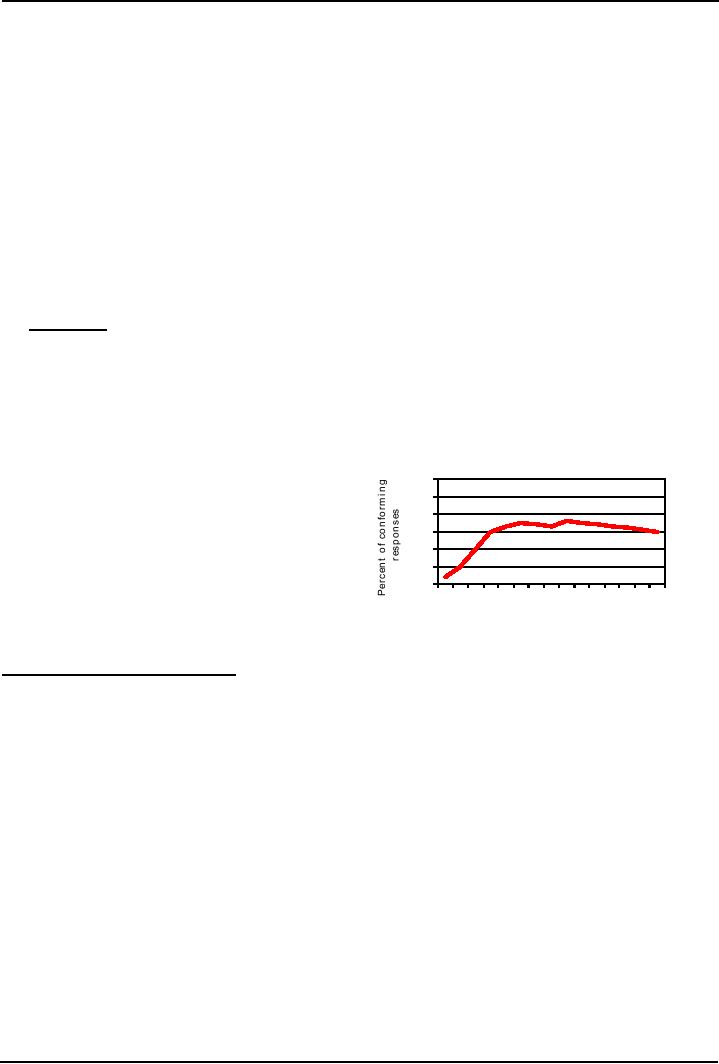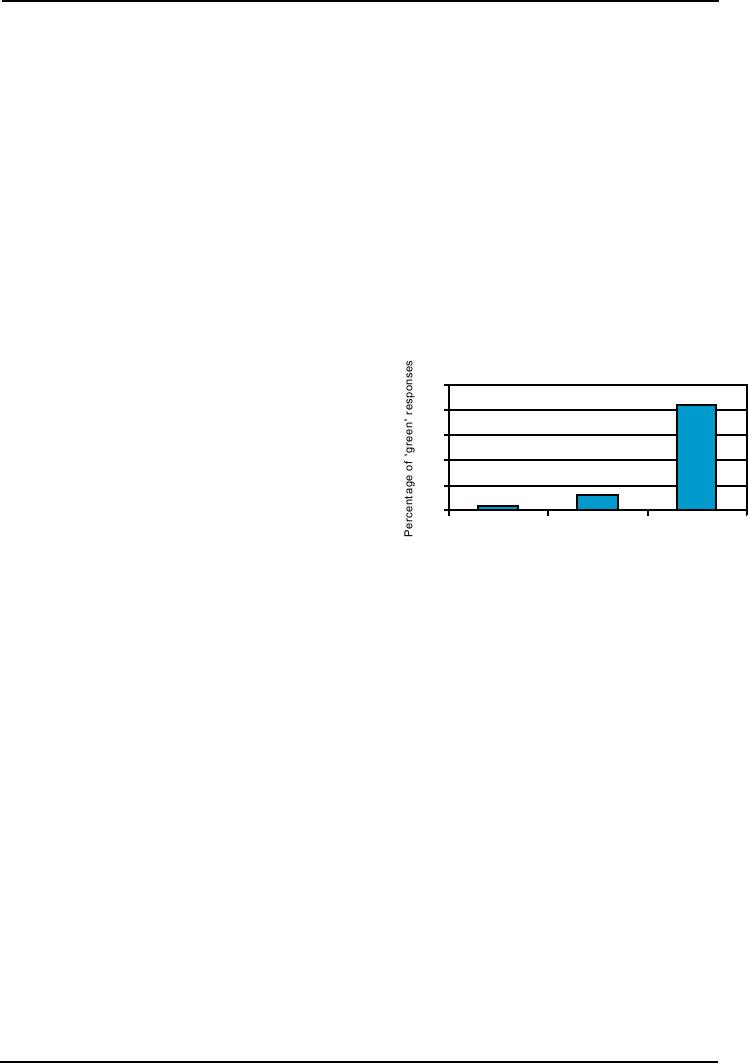 |

Social
Psychology (PSY403)
VU
Lesson
32
SOCIAL
INFLUENCE (CONTINE.........)
Aims
�
Introduce
the concept of conformity and related
concept
Objectives
�
Describe
the classic studies of conformity, e.g.,
Asch's experiments
�
Describe
factors that influence
conformity
�
Discuss
Schachter's work on rejection of the
nonconformist
�
Describe
minority influences
Classic
& contemporary conformity
research
Social
norms may come into
play in uncertain situations
(such as ambiguous light movements)
but
what
about when we do not agree
with the majority? This is
true for many situations
when people seem
to
conform to a majority viewpoint even
though they disagree (e.g.,
jury-based decision
making).
Example: In
the spring of 1992, Los
Angeles was rocked by its
worst race riots in 25 years
following a
jury
trial in which 4 white LA
police officers were acquitted of
using excessive force in
beating a black
man
Rodney King. The beating
was captured in a videotape by a
photographer. One jury
considered
them
guilty, but as other two
members of jury blamed King.
She had to change from
guilty to not
guilty,
however she stated "to me
they seemed blind and could
not get their glasses clean, I
wish they
could
see".
Asch's
experiments on group pressure
(1951)
�
`Visual
perception experiment'
�
Participants were
told that 6 others would
also be taking part (but
all 6 were confederates)
The
task
Participants
required calling out the number
corresponding to the line that
was equal in length to
the
standard
line.
�
They
had to make a total of 18 judgments
5
out of 6 confederates stated
judgments
before
the participant.
�
For
the first 2 judgments confederates
chose
the correct line, after which
they
unanimously
chose a clearly incorrect
line
in
12 of the remaining 16 trials
Figure
1
�
Participants
conformed to the (incorrect) majority on
37% of trials; 76% of
participants conformed
on
at least one of the
trials
�
In
contrast when participants
made judgments privately only 1%
made errors
�
Why
such blatant conformity when
clearly incorrect?
�
People
find it easier to conform
than to challenge unanimous opinion of
others
These
results are illustrated in
Figure 2 below:
129

Social
Psychology (PSY403)
VU
Post-conformity
change of behavior
�
How do
people typically react to the
reality of their
conforming
behavior?
�
Research
suggests that almost everyone
attempts to
reconstruct
the facts (Buehler Griffin,
1884). When it runs
counter
to their own private views,
two things happen:
whether
people conform to what
majority says, or facts
force
one's
agreement with that
standard.
�
Post-conformity
change of behavior allows conformists
to
justify
their behavior and maintain
cognitive consistency
Two
sources of group pressure (Deutsh &
Gerard, 1955)
�
Normative
influence:
o
Conformity
due to the desire to gain rewards,
or
avoid
punishment from the group (i.e.,
negative evaluation, people
laughing at you).
This
was
most likely in Asch's experiments. In
such a situation, the question
was whether to
stick
to their own judgment or go
along with the group and
avoid uncomfortable
stares:
"Fitting
in" was of greater concern to
people when there was no
ambiguity in the situation.
Another
experiment conducted in 1952 by Asch
showed that when 16 were
participants
and
only one confederate was
giving wrong answers. First
respondents were surprised on
his
answers then started
laughing uproariously.
�
Informational
influence:
o
Conformity
due to the desire to gain information
(i.e., in ambiguous situations where
you
are
not sure of your own
perception). Information influence
was most likely in
Sherif's
experiments.
�
But
both can occur in same
situation: Virginia (the
third jury) accepted group
pressure that Rodney
King's
tape did not provide
enough information (normative
Influence) and began to consider
other
jurors'
interpretation (informational
influence)
Schachter's
work on rejection of the
nonconformist
�
A
group of 8-10 volunteers to
form a "case study club" to
discuss the case of a juvenile
delinquent
"Johnny
Rocco"
�
It
was expected that the participants
will take the favoring
position
�
Making
recommendations of what the authorities
should do on a seven-point
love-punishment
scale
�
Three
confederates in each group
taking differing "deviate"
(punishment) position
�
How
the participants reacted to the
deviates?
o
First
trying to persuade
o
Rejecting
nonconformists from future
discussions
More
research and
implications
�
A
meta-analysis of 23 Schachter-like deviant
studies suggest that
rejection by group is more
likely
when
there are only one or two
nonconformists (Tata et al.,
1996)
130

Social
Psychology (PSY403)
VU
�
Such
people are banished from the
group. Social rejection is
final and perhaps most
powerful form
of
normative influence directed
toward nonconformists; one of the
primary causes of
depression
(Nolan
et al., 2003)
�
Many
teenagers conform to their
friends' alcohol and drug
use to gain acceptance
(Williams &
Zadro,
2001)
�
It
is more problematic for adolescents as
their attitudes are still
being formed for political
and
social
issues.
Factors
that influence
conformity
�
Group
size
�
Group
cohesiveness
�
Social
support
Group
size
Conformity
increases with group size,
but only up to 3 people...
When Asch increased the number
of
unanimous
confederates from 1 to 15,
conformity increased but it
was on its peak between 3-4
points,
and
then actually tapered
off.
Jennifer
Campbell & Patricia
Fairey
(1989):
Group
size and
conformity
�
Group
size is important when the
social
reality
is clear (judgments easy).
60
�
Size
of the group is
relatively
50
unimportant
when social reality is
40
ambiguous
(judgments difficult)
30
20
�
In
ambiguous situation one or two
10
people
may influence you just as
well as
0
3
or 4.
1
3
5
7
9
11
13
15
The
effect of group size on
conformity can
Number
of confeder ates
be
clearly seen in Figure 3, as shown
below:
Group
cohesiveness (Hogg, 1992)
�
Cohesiveness
refers to a condition of the group when
members are highly attracted to one
another.
�
With
strong sense of togetherness they
will be intolerant of those
who hold differing
opinions.
�
In
general cohesive groups engender more conformity than
noncohesive groups (Christensen et al.,
2004).
�
In
Schachter's experiments, when the group
was highly cohesive it exerted its
greatest pressure on
deviates.
Social
support (Hogg, 1992)
�
In
Asch's studies if just one
confederate agreed with the participant
then conformity drops
dramatically
(Asch, 1956).
�
The
same occurs even if one confederate
disagreed with everyone's
opinions (Asch; Allen
&
Levine,
1971).
�
Thus
any breaking of social consensus is
enough to reduce
conformity
131

Social
Psychology (PSY403)
VU
�
But
- must be consistent, when a confederate
who initially agrees with
the participant then
switches
to
the majority, conformity returns to
normal (Asch, 1955). Thus to
promote nonconformity, one
should
voice dissent, and do so
early and
consistently.
Minority
influence
History
is filled with stories of
lone individuals or small
relatively powerless groups who
express
unpopular
views and they endure abuse
from majority until
eventually their views are
accepted. Those
who
dissent from majority are
heartily disliked. Style of
behavior in presenting nonconformist
behavior
is
important:
�
Sometimes
a minority can shift the
views of a majority
�
Minorities
will have an influence only
when they are consistent and
confident.
�
"Cautious,
careful people always
casting about to preserve
their reputation and social
standing,
never
can they bring about a
reform" (19th
cent feminist Susan
Anthony)
Moscovici,
Lage, & Naffrechoux
(1969)
Conformity
to inconsistent and
�
`Visual
perception experiment'
consistent
minoirities
�
Judgments
of blue slides as green or blue
�
4
participants and 2 confederates per
group
10
�
Consistent and
nonconsistent minority
8
6
The
results of this experiment
are illustrated in
Figure
4:
4
2
Under
certain conditions minority
can
0
influence
majority
Control
Inconsistent
Consistent
�
Given
the
normative
consequences
minority
minority
(punishment)
and
the
informational
advantages
(consensus) of conforming, if a
minority
consistently `sticks to its guns'
then
others
attribute some degree of
credibility to the minority
argument.
�
Why
majority's opinion is given
importance, there is a common belief that
there is truth in numbers
(informational
influence), and then people
are affected by these
numbers (normative
influence).
That
is why people adopt
majority's opinion without
much critical analysis.
�
Minority's
opinion is viewed negatively, and
thus will need greater time
to register with group
members.
However, if other views are
adopted, they are more resistant to
change. Why because
attitude
changed through central
route analysis is stronger and more
difficult to change
than
attitude
changed through lazy
thinking (peripheral
cues).
�
Although
overt change toward minority
influence may not readily
take place, it often stimulates
divergent
thinking, a cognitive approach in which
one considers a problem from
varying
perspective
�
Once
minority views were accepted,
they had an enduring
effect.
�
Minority
influence also stimulants `divergent
thinking' (Legrenzi, Butera,
Mugny, & Perez,
1991)
�
So,
whilst it may be difficult to
change majority views,
minority groups can stimulate
greater
thought
on the issue which may, over
time, lead to changes in
majority attitudes.
132

Social
Psychology (PSY403)
VU
The
following 3 conditions are essential
for a minority to have its
influence:
1.
The
minority must also be
flexible
and open-minded
Example:
Nelson Mandela (double
minority) was successful in
changing the social and
o
political
landscape of South Africa with
his consistency and
confidence coupled with
his
willingness
to negotiate with White
apartheid leaders. In contrast, minority
people will
reduce
their influence if are
rigid.
Single
minority are more likely to
influence the majority Double
minority status indicates
o
that
Mandela was different from
Whites in beliefs, and also in
group membership. An
example
of a single minority is a heterosexual
advocating the rights of gay. In
contrast, a
gay
advocating such rights is
having a double
minority.
"The
power of a movement lies in the fact
that it can indeed change
the habits of people.
o
This
change is not the result of
force but of dedication, of
moral persuasion" (Steve Biko,
South
African political leader,
1946-1977).
2.
Degree
of difference between
minority & majority
3.
Minorities have the strongest influence
when they take positions
in the cultural normative
directions.
Norms:
e.g., beliefs about equality and human
justice may be rejected by some
people,
they
still will be in line with
the beliefs of most
people.
It
is not always essential that
minority views are accepted,
majority can impose
sanctions and
withdraw
rewards
from its members, and this
is enough to keep public compliance with
the majority.
Reading
�
Franzoi,
S. (2003). Social
Psychology. Boston:
McGraw-Hill. Chapter 9.
Other
Readings
�
Lord,
C.G. (1997). Social
Psychology. Orlando:
Harcourt Brace and Company. Chapter
8.
�
David
G. Myers, D. G. (2002). Social
Psychology (7th ed.).
New York:
McGraw-Hill.
133
Table of Contents:
- INTRODUCTION TO SOCIAL PSYCHOLOGY:Readings, Main Elements of Definitions
- INTRODUCTION TO SOCIAL PSYCHOLOGY:Social Psychology and Sociology
- CONDUCTING RESEARCH IN SOCIAL PSYCHOLOGY:Scientific Method
- CONDUCTING RESEARCH IN SOCIAL PSYCHOLOGY:Evaluate Ethics
- CONDUCTING RESEARCH IN SOCIAL PSYCHOLOGY RESEARCH PROCESS, DESIGNS AND METHODS (CONTINUED)
- CONDUCTING RESEARCH IN SOCIAL PSYCHOLOGY OBSERVATIONAL METHOD
- CONDUCTING RESEARCH IN SOCIAL PSYCHOLOGY CORRELATIONAL METHOD:
- CONDUCTING RESEARCH IN SOCIAL PSYCHOLOGY EXPERIMENTAL METHOD
- THE SELF:Meta Analysis, THE INTERNET, BRAIN-IMAGING TECHNIQUES
- THE SELF (CONTINUED):Development of Self awareness, SELF REGULATION
- THE SELF (CONTINUE…….):Journal Activity, POSSIBLE HISTORICAL EFFECTS
- THE SELF (CONTINUE……….):SELF-SCHEMAS, SELF-COMPLEXITY
- PERSON PERCEPTION:Impression Formation, Facial Expressions
- PERSON PERCEPTION (CONTINUE…..):GENDER SOCIALIZATION, Integrating Impressions
- PERSON PERCEPTION: WHEN PERSON PERCEPTION IS MOST CHALLENGING
- ATTRIBUTION:The locus of causality, Stability & Controllability
- ATTRIBUTION ERRORS:Biases in Attribution, Cultural differences
- SOCIAL COGNITION:We are categorizing creatures, Developing Schemas
- SOCIAL COGNITION (CONTINUE…….):Counterfactual Thinking, Confirmation bias
- ATTITUDES:Affective component, Behavioral component, Cognitive component
- ATTITUDE FORMATION:Classical conditioning, Subliminal conditioning
- ATTITUDE AND BEHAVIOR:Theory of planned behavior, Attitude strength
- ATTITUDE CHANGE:Factors affecting dissonance, Likeability
- ATTITUDE CHANGE (CONTINUE……….):Attitudinal Inoculation, Audience Variables
- PREJUDICE AND DISCRIMINATION:Activity on Cognitive Dissonance, Categorization
- PREJUDICE AND DISCRIMINATION (CONTINUE……….):Religion, Stereotype threat
- REDUCING PREJUDICE AND DISCRIMINATION:The contact hypothesis
- INTERPERSONAL ATTRACTION:Reasons for affiliation, Theory of Social exchange
- INTERPERSONAL ATTRACTION (CONTINUE……..):Physical attractiveness
- INTIMATE RELATIONSHIPS:Applied Social Psychology Lab
- SOCIAL INFLUENCE:Attachment styles & Friendship, SOCIAL INTERACTIONS
- SOCIAL INFLUENCE (CONTINE………):Normative influence, Informational influence
- SOCIAL INFLUENCE (CONTINUE……):Crimes of Obedience, Predictions
- AGGRESSION:Identifying Aggression, Instrumental aggression
- AGGRESSION (CONTINUE……):The Cognitive-Neo-associationist Model
- REDUCING AGGRESSION:Punishment, Incompatible response strategy
- PROSOCIAL BEHAVIOR:Types of Helping, Reciprocal helping, Norm of responsibility
- PROSOCIAL BEHAVIOR (CONTINUE………):Bystander Intervention, Diffusion of responsibility
- GROUP BEHAVIOR:Applied Social Psychology Lab, Basic Features of Groups
- GROUP BEHAVIOR (CONTINUE…………):Social Loafing, Deindividuation
- up Decision GROUP BEHAVIOR (CONTINUE……….):GroProcess, Group Polarization
- INTERPERSONAL POWER: LEADERSHIP, The Situational Perspective, Information power
- SOCIAL PSYCHOLOGY APPLIED: SOCIAL PSYCHOLOGY IN COURT
- SOCIAL PSYCHOLOGY APPLIED: SOCIAL PSYCHOLOGY IN CLINIC
- FINAL REVIEW:Social Psychology and related fields, History, Social cognition